Economics and International Trade
VerifiedAdded on 2023/03/30
|7
|2173
|289
AI Summary
This report provides a comprehensive analysis of the mining industry in Australia, focusing on the market structure, demand and supply factors, elasticity, and the impact of recent events. The industry is an oligopoly, dominated by a few major companies. The demand for iron ore is influenced by substitutes and price, while the supply is determined by production costs and future market expectations. The industry has an inelastic demand, and recent events like Cyclone Veronica have affected both the demand and supply of iron ore.
Contribute Materials
Your contribution can guide someone’s learning journey. Share your
documents today.
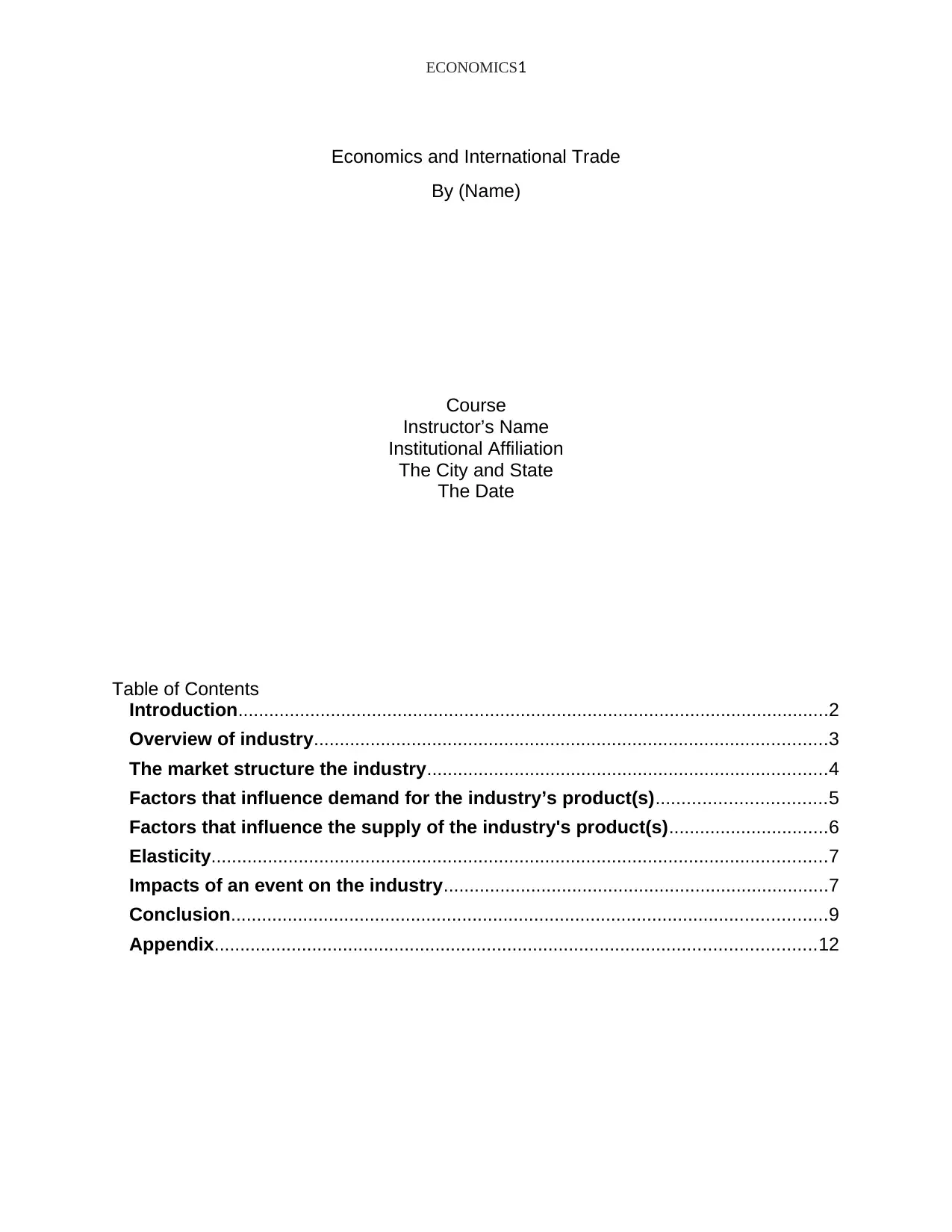
ECONOMICS1
Economics and International Trade
By (Name)
Course
Instructor’s Name
Institutional Affiliation
The City and State
The Date
Table of Contents
Introduction...................................................................................................................2
Overview of industry....................................................................................................3
The market structure the industry..............................................................................4
Factors that influence demand for the industry’s product(s).................................5
Factors that influence the supply of the industry's product(s)...............................6
Elasticity........................................................................................................................7
Impacts of an event on the industry...........................................................................7
Conclusion....................................................................................................................9
Appendix.....................................................................................................................12
Economics and International Trade
By (Name)
Course
Instructor’s Name
Institutional Affiliation
The City and State
The Date
Table of Contents
Introduction...................................................................................................................2
Overview of industry....................................................................................................3
The market structure the industry..............................................................................4
Factors that influence demand for the industry’s product(s).................................5
Factors that influence the supply of the industry's product(s)...............................6
Elasticity........................................................................................................................7
Impacts of an event on the industry...........................................................................7
Conclusion....................................................................................................................9
Appendix.....................................................................................................................12
Secure Best Marks with AI Grader
Need help grading? Try our AI Grader for instant feedback on your assignments.
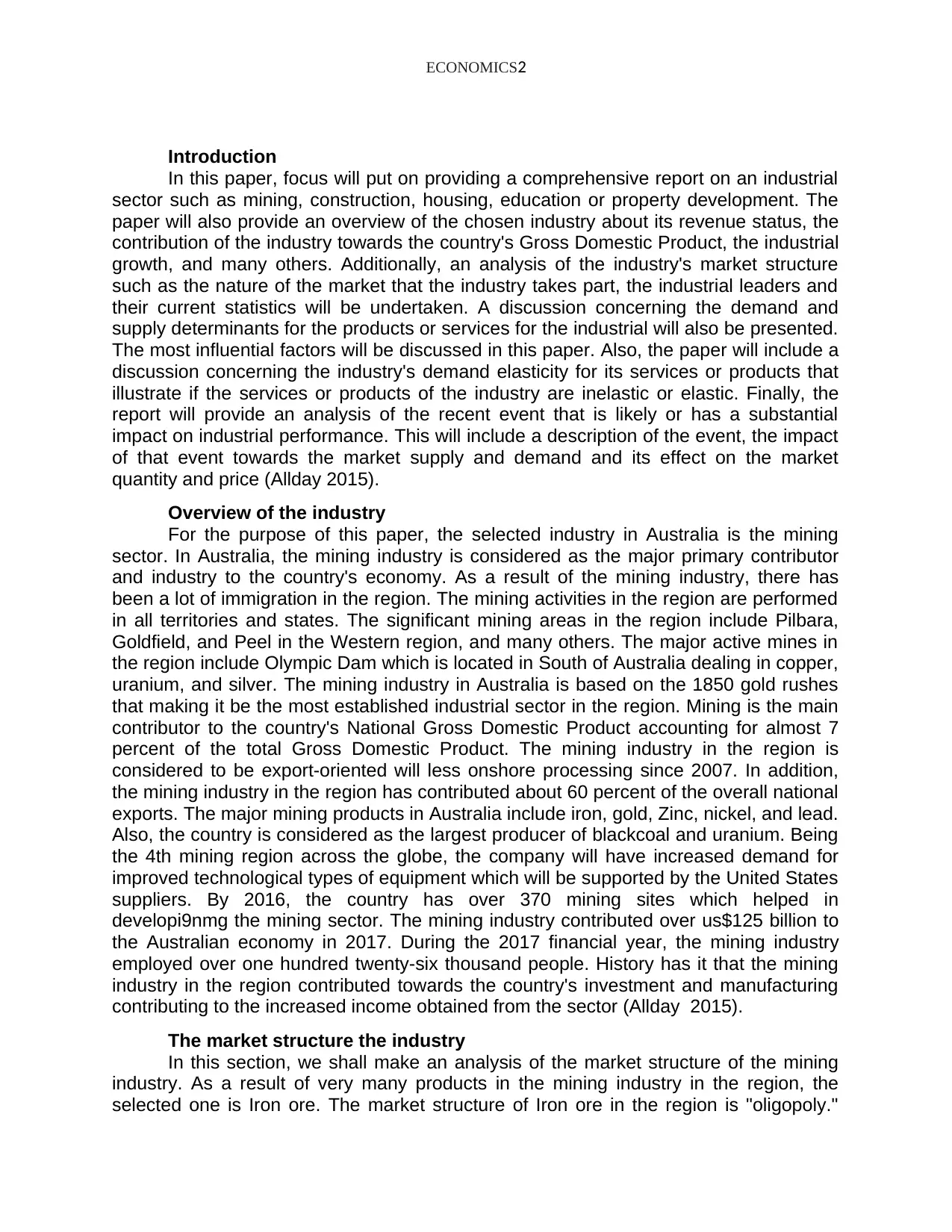
ECONOMICS2
Introduction
In this paper, focus will put on providing a comprehensive report on an industrial
sector such as mining, construction, housing, education or property development. The
paper will also provide an overview of the chosen industry about its revenue status, the
contribution of the industry towards the country's Gross Domestic Product, the industrial
growth, and many others. Additionally, an analysis of the industry's market structure
such as the nature of the market that the industry takes part, the industrial leaders and
their current statistics will be undertaken. A discussion concerning the demand and
supply determinants for the products or services for the industrial will also be presented.
The most influential factors will be discussed in this paper. Also, the paper will include a
discussion concerning the industry's demand elasticity for its services or products that
illustrate if the services or products of the industry are inelastic or elastic. Finally, the
report will provide an analysis of the recent event that is likely or has a substantial
impact on industrial performance. This will include a description of the event, the impact
of that event towards the market supply and demand and its effect on the market
quantity and price (Allday 2015).
Overview of the industry
For the purpose of this paper, the selected industry in Australia is the mining
sector. In Australia, the mining industry is considered as the major primary contributor
and industry to the country's economy. As a result of the mining industry, there has
been a lot of immigration in the region. The mining activities in the region are performed
in all territories and states. The significant mining areas in the region include Pilbara,
Goldfield, and Peel in the Western region, and many others. The major active mines in
the region include Olympic Dam which is located in South of Australia dealing in copper,
uranium, and silver. The mining industry in Australia is based on the 1850 gold rushes
that making it be the most established industrial sector in the region. Mining is the main
contributor to the country's National Gross Domestic Product accounting for almost 7
percent of the total Gross Domestic Product. The mining industry in the region is
considered to be export-oriented will less onshore processing since 2007. In addition,
the mining industry in the region has contributed about 60 percent of the overall national
exports. The major mining products in Australia include iron, gold, Zinc, nickel, and lead.
Also, the country is considered as the largest producer of blackcoal and uranium. Being
the 4th mining region across the globe, the company will have increased demand for
improved technological types of equipment which will be supported by the United States
suppliers. By 2016, the country has over 370 mining sites which helped in
developi9nmg the mining sector. The mining industry contributed over us$125 billion to
the Australian economy in 2017. During the 2017 financial year, the mining industry
employed over one hundred twenty-six thousand people. History has it that the mining
industry in the region contributed towards the country's investment and manufacturing
contributing to the increased income obtained from the sector (Allday 2015).
The market structure the industry
In this section, we shall make an analysis of the market structure of the mining
industry. As a result of very many products in the mining industry in the region, the
selected one is Iron ore. The market structure of Iron ore in the region is "oligopoly."
Introduction
In this paper, focus will put on providing a comprehensive report on an industrial
sector such as mining, construction, housing, education or property development. The
paper will also provide an overview of the chosen industry about its revenue status, the
contribution of the industry towards the country's Gross Domestic Product, the industrial
growth, and many others. Additionally, an analysis of the industry's market structure
such as the nature of the market that the industry takes part, the industrial leaders and
their current statistics will be undertaken. A discussion concerning the demand and
supply determinants for the products or services for the industrial will also be presented.
The most influential factors will be discussed in this paper. Also, the paper will include a
discussion concerning the industry's demand elasticity for its services or products that
illustrate if the services or products of the industry are inelastic or elastic. Finally, the
report will provide an analysis of the recent event that is likely or has a substantial
impact on industrial performance. This will include a description of the event, the impact
of that event towards the market supply and demand and its effect on the market
quantity and price (Allday 2015).
Overview of the industry
For the purpose of this paper, the selected industry in Australia is the mining
sector. In Australia, the mining industry is considered as the major primary contributor
and industry to the country's economy. As a result of the mining industry, there has
been a lot of immigration in the region. The mining activities in the region are performed
in all territories and states. The significant mining areas in the region include Pilbara,
Goldfield, and Peel in the Western region, and many others. The major active mines in
the region include Olympic Dam which is located in South of Australia dealing in copper,
uranium, and silver. The mining industry in Australia is based on the 1850 gold rushes
that making it be the most established industrial sector in the region. Mining is the main
contributor to the country's National Gross Domestic Product accounting for almost 7
percent of the total Gross Domestic Product. The mining industry in the region is
considered to be export-oriented will less onshore processing since 2007. In addition,
the mining industry in the region has contributed about 60 percent of the overall national
exports. The major mining products in Australia include iron, gold, Zinc, nickel, and lead.
Also, the country is considered as the largest producer of blackcoal and uranium. Being
the 4th mining region across the globe, the company will have increased demand for
improved technological types of equipment which will be supported by the United States
suppliers. By 2016, the country has over 370 mining sites which helped in
developi9nmg the mining sector. The mining industry contributed over us$125 billion to
the Australian economy in 2017. During the 2017 financial year, the mining industry
employed over one hundred twenty-six thousand people. History has it that the mining
industry in the region contributed towards the country's investment and manufacturing
contributing to the increased income obtained from the sector (Allday 2015).
The market structure the industry
In this section, we shall make an analysis of the market structure of the mining
industry. As a result of very many products in the mining industry in the region, the
selected one is Iron ore. The market structure of Iron ore in the region is "oligopoly."
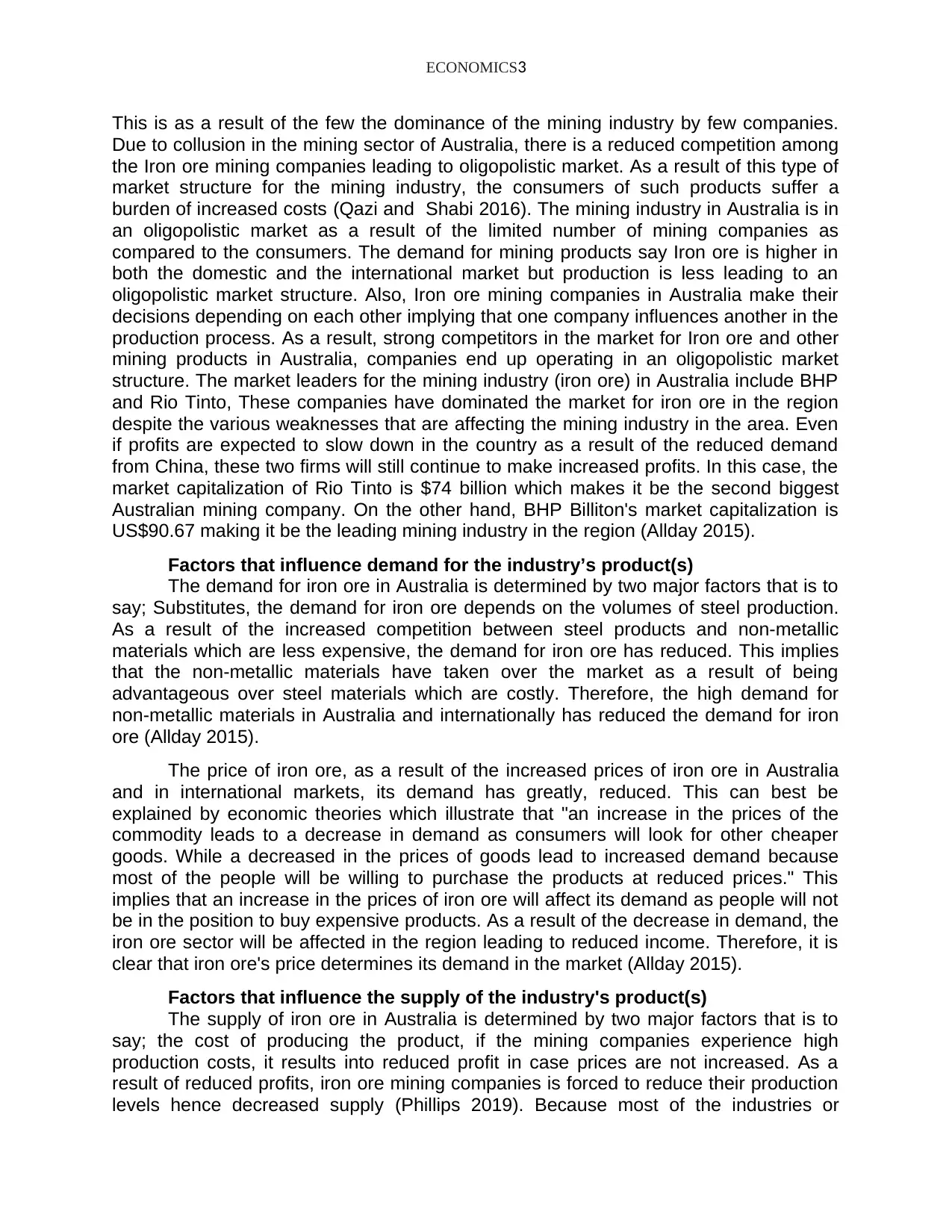
ECONOMICS3
This is as a result of the few the dominance of the mining industry by few companies.
Due to collusion in the mining sector of Australia, there is a reduced competition among
the Iron ore mining companies leading to oligopolistic market. As a result of this type of
market structure for the mining industry, the consumers of such products suffer a
burden of increased costs (Qazi and Shabi 2016). The mining industry in Australia is in
an oligopolistic market as a result of the limited number of mining companies as
compared to the consumers. The demand for mining products say Iron ore is higher in
both the domestic and the international market but production is less leading to an
oligopolistic market structure. Also, Iron ore mining companies in Australia make their
decisions depending on each other implying that one company influences another in the
production process. As a result, strong competitors in the market for Iron ore and other
mining products in Australia, companies end up operating in an oligopolistic market
structure. The market leaders for the mining industry (iron ore) in Australia include BHP
and Rio Tinto, These companies have dominated the market for iron ore in the region
despite the various weaknesses that are affecting the mining industry in the area. Even
if profits are expected to slow down in the country as a result of the reduced demand
from China, these two firms will still continue to make increased profits. In this case, the
market capitalization of Rio Tinto is $74 billion which makes it be the second biggest
Australian mining company. On the other hand, BHP Billiton's market capitalization is
US$90.67 making it be the leading mining industry in the region (Allday 2015).
Factors that influence demand for the industry’s product(s)
The demand for iron ore in Australia is determined by two major factors that is to
say; Substitutes, the demand for iron ore depends on the volumes of steel production.
As a result of the increased competition between steel products and non-metallic
materials which are less expensive, the demand for iron ore has reduced. This implies
that the non-metallic materials have taken over the market as a result of being
advantageous over steel materials which are costly. Therefore, the high demand for
non-metallic materials in Australia and internationally has reduced the demand for iron
ore (Allday 2015).
The price of iron ore, as a result of the increased prices of iron ore in Australia
and in international markets, its demand has greatly, reduced. This can best be
explained by economic theories which illustrate that "an increase in the prices of the
commodity leads to a decrease in demand as consumers will look for other cheaper
goods. While a decreased in the prices of goods lead to increased demand because
most of the people will be willing to purchase the products at reduced prices." This
implies that an increase in the prices of iron ore will affect its demand as people will not
be in the position to buy expensive products. As a result of the decrease in demand, the
iron ore sector will be affected in the region leading to reduced income. Therefore, it is
clear that iron ore's price determines its demand in the market (Allday 2015).
Factors that influence the supply of the industry's product(s)
The supply of iron ore in Australia is determined by two major factors that is to
say; the cost of producing the product, if the mining companies experience high
production costs, it results into reduced profit in case prices are not increased. As a
result of reduced profits, iron ore mining companies is forced to reduce their production
levels hence decreased supply (Phillips 2019). Because most of the industries or
This is as a result of the few the dominance of the mining industry by few companies.
Due to collusion in the mining sector of Australia, there is a reduced competition among
the Iron ore mining companies leading to oligopolistic market. As a result of this type of
market structure for the mining industry, the consumers of such products suffer a
burden of increased costs (Qazi and Shabi 2016). The mining industry in Australia is in
an oligopolistic market as a result of the limited number of mining companies as
compared to the consumers. The demand for mining products say Iron ore is higher in
both the domestic and the international market but production is less leading to an
oligopolistic market structure. Also, Iron ore mining companies in Australia make their
decisions depending on each other implying that one company influences another in the
production process. As a result, strong competitors in the market for Iron ore and other
mining products in Australia, companies end up operating in an oligopolistic market
structure. The market leaders for the mining industry (iron ore) in Australia include BHP
and Rio Tinto, These companies have dominated the market for iron ore in the region
despite the various weaknesses that are affecting the mining industry in the area. Even
if profits are expected to slow down in the country as a result of the reduced demand
from China, these two firms will still continue to make increased profits. In this case, the
market capitalization of Rio Tinto is $74 billion which makes it be the second biggest
Australian mining company. On the other hand, BHP Billiton's market capitalization is
US$90.67 making it be the leading mining industry in the region (Allday 2015).
Factors that influence demand for the industry’s product(s)
The demand for iron ore in Australia is determined by two major factors that is to
say; Substitutes, the demand for iron ore depends on the volumes of steel production.
As a result of the increased competition between steel products and non-metallic
materials which are less expensive, the demand for iron ore has reduced. This implies
that the non-metallic materials have taken over the market as a result of being
advantageous over steel materials which are costly. Therefore, the high demand for
non-metallic materials in Australia and internationally has reduced the demand for iron
ore (Allday 2015).
The price of iron ore, as a result of the increased prices of iron ore in Australia
and in international markets, its demand has greatly, reduced. This can best be
explained by economic theories which illustrate that "an increase in the prices of the
commodity leads to a decrease in demand as consumers will look for other cheaper
goods. While a decreased in the prices of goods lead to increased demand because
most of the people will be willing to purchase the products at reduced prices." This
implies that an increase in the prices of iron ore will affect its demand as people will not
be in the position to buy expensive products. As a result of the decrease in demand, the
iron ore sector will be affected in the region leading to reduced income. Therefore, it is
clear that iron ore's price determines its demand in the market (Allday 2015).
Factors that influence the supply of the industry's product(s)
The supply of iron ore in Australia is determined by two major factors that is to
say; the cost of producing the product, if the mining companies experience high
production costs, it results into reduced profit in case prices are not increased. As a
result of reduced profits, iron ore mining companies is forced to reduce their production
levels hence decreased supply (Phillips 2019). Because most of the industries or
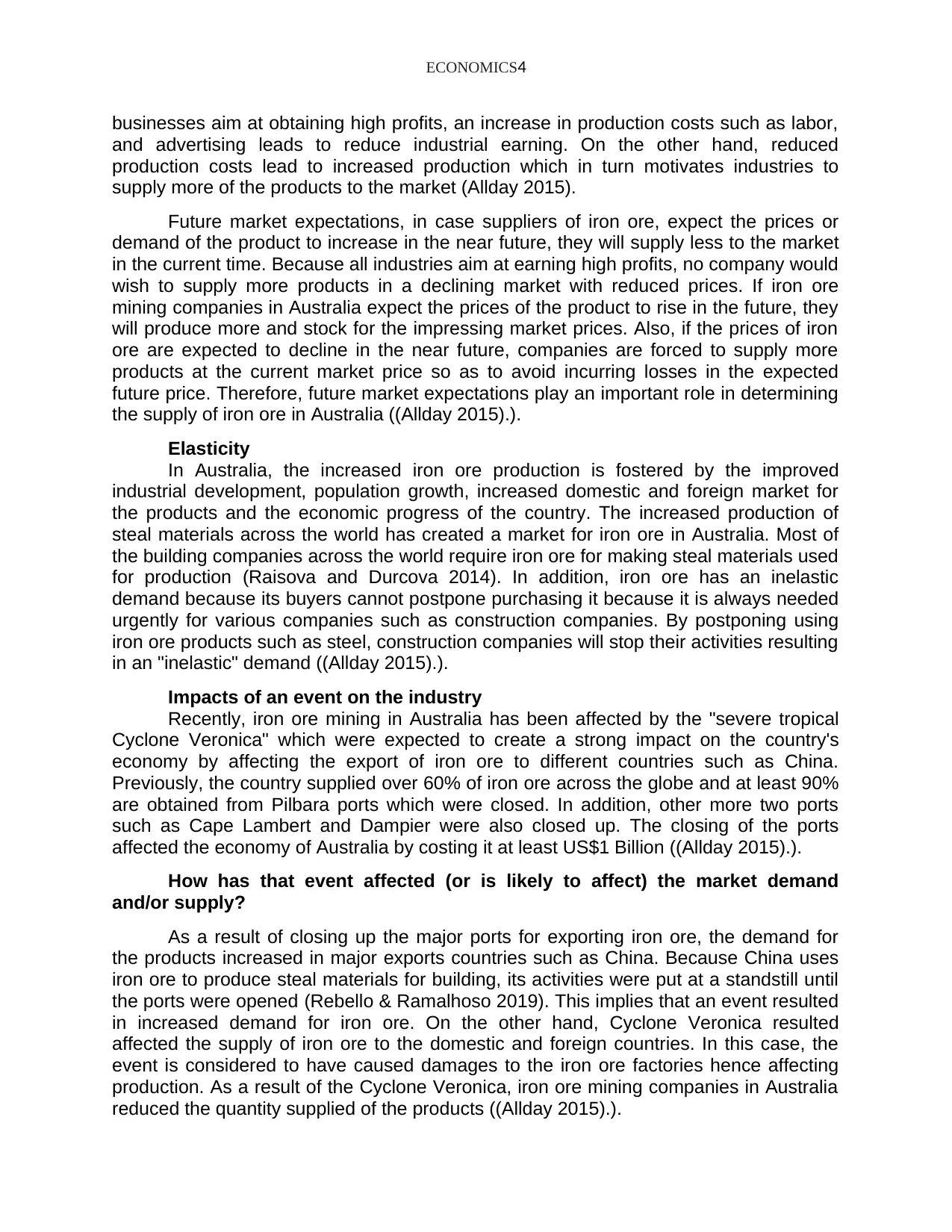
ECONOMICS4
businesses aim at obtaining high profits, an increase in production costs such as labor,
and advertising leads to reduce industrial earning. On the other hand, reduced
production costs lead to increased production which in turn motivates industries to
supply more of the products to the market (Allday 2015).
Future market expectations, in case suppliers of iron ore, expect the prices or
demand of the product to increase in the near future, they will supply less to the market
in the current time. Because all industries aim at earning high profits, no company would
wish to supply more products in a declining market with reduced prices. If iron ore
mining companies in Australia expect the prices of the product to rise in the future, they
will produce more and stock for the impressing market prices. Also, if the prices of iron
ore are expected to decline in the near future, companies are forced to supply more
products at the current market price so as to avoid incurring losses in the expected
future price. Therefore, future market expectations play an important role in determining
the supply of iron ore in Australia ((Allday 2015).).
Elasticity
In Australia, the increased iron ore production is fostered by the improved
industrial development, population growth, increased domestic and foreign market for
the products and the economic progress of the country. The increased production of
steal materials across the world has created a market for iron ore in Australia. Most of
the building companies across the world require iron ore for making steal materials used
for production (Raisova and Durcova 2014). In addition, iron ore has an inelastic
demand because its buyers cannot postpone purchasing it because it is always needed
urgently for various companies such as construction companies. By postponing using
iron ore products such as steel, construction companies will stop their activities resulting
in an "inelastic" demand ((Allday 2015).).
Impacts of an event on the industry
Recently, iron ore mining in Australia has been affected by the "severe tropical
Cyclone Veronica" which were expected to create a strong impact on the country's
economy by affecting the export of iron ore to different countries such as China.
Previously, the country supplied over 60% of iron ore across the globe and at least 90%
are obtained from Pilbara ports which were closed. In addition, other more two ports
such as Cape Lambert and Dampier were also closed up. The closing of the ports
affected the economy of Australia by costing it at least US$1 Billion ((Allday 2015).).
How has that event affected (or is likely to affect) the market demand
and/or supply?
As a result of closing up the major ports for exporting iron ore, the demand for
the products increased in major exports countries such as China. Because China uses
iron ore to produce steal materials for building, its activities were put at a standstill until
the ports were opened (Rebello & Ramalhoso 2019). This implies that an event resulted
in increased demand for iron ore. On the other hand, Cyclone Veronica resulted
affected the supply of iron ore to the domestic and foreign countries. In this case, the
event is considered to have caused damages to the iron ore factories hence affecting
production. As a result of the Cyclone Veronica, iron ore mining companies in Australia
reduced the quantity supplied of the products ((Allday 2015).).
businesses aim at obtaining high profits, an increase in production costs such as labor,
and advertising leads to reduce industrial earning. On the other hand, reduced
production costs lead to increased production which in turn motivates industries to
supply more of the products to the market (Allday 2015).
Future market expectations, in case suppliers of iron ore, expect the prices or
demand of the product to increase in the near future, they will supply less to the market
in the current time. Because all industries aim at earning high profits, no company would
wish to supply more products in a declining market with reduced prices. If iron ore
mining companies in Australia expect the prices of the product to rise in the future, they
will produce more and stock for the impressing market prices. Also, if the prices of iron
ore are expected to decline in the near future, companies are forced to supply more
products at the current market price so as to avoid incurring losses in the expected
future price. Therefore, future market expectations play an important role in determining
the supply of iron ore in Australia ((Allday 2015).).
Elasticity
In Australia, the increased iron ore production is fostered by the improved
industrial development, population growth, increased domestic and foreign market for
the products and the economic progress of the country. The increased production of
steal materials across the world has created a market for iron ore in Australia. Most of
the building companies across the world require iron ore for making steal materials used
for production (Raisova and Durcova 2014). In addition, iron ore has an inelastic
demand because its buyers cannot postpone purchasing it because it is always needed
urgently for various companies such as construction companies. By postponing using
iron ore products such as steel, construction companies will stop their activities resulting
in an "inelastic" demand ((Allday 2015).).
Impacts of an event on the industry
Recently, iron ore mining in Australia has been affected by the "severe tropical
Cyclone Veronica" which were expected to create a strong impact on the country's
economy by affecting the export of iron ore to different countries such as China.
Previously, the country supplied over 60% of iron ore across the globe and at least 90%
are obtained from Pilbara ports which were closed. In addition, other more two ports
such as Cape Lambert and Dampier were also closed up. The closing of the ports
affected the economy of Australia by costing it at least US$1 Billion ((Allday 2015).).
How has that event affected (or is likely to affect) the market demand
and/or supply?
As a result of closing up the major ports for exporting iron ore, the demand for
the products increased in major exports countries such as China. Because China uses
iron ore to produce steal materials for building, its activities were put at a standstill until
the ports were opened (Rebello & Ramalhoso 2019). This implies that an event resulted
in increased demand for iron ore. On the other hand, Cyclone Veronica resulted
affected the supply of iron ore to the domestic and foreign countries. In this case, the
event is considered to have caused damages to the iron ore factories hence affecting
production. As a result of the Cyclone Veronica, iron ore mining companies in Australia
reduced the quantity supplied of the products ((Allday 2015).).
Secure Best Marks with AI Grader
Need help grading? Try our AI Grader for instant feedback on your assignments.

ECONOMICS5
How has that event affected (or is likely to affect) the market demand
and/or supply?
Figure one: Market Demand/supply diagram
Source:
Explanation: The above figure illustrates that as a result of Cyclone Veronica in
Australia, the prices of iron ore are expected to rise from P1 to P2. This is as a result of
temporary stopping exports on major ports in the Country. This implies that the demand
for iron ore will be high in low market supply. As a result, the prices of steal materials in
China will raise given the fact that mining companies in Australia will not be in the
position to operate. In addition, the quantity of the products in the market will reduce
from Q2 to Q1 because production will be low and export will be stopped (Allday 2015).
Conclusion
In Australia, the iron ore mining industry is considered to be an "oligopoly" market
structure with BHP and Rio Tinto as the market leaders. It is important to note that a
market structure of oligopoly comprise of a few dominant firms with significant market
share and control over prices. None the less, the market is also made up of some
monopolistic behaviors. The Mining Industry in Australia is known as the major
contributor to the country's Gross Domestic Product. The iron ore industry in Australia
has an inelastic demand as a result of its reduced sensitivity to price changes. In brief,
iron ore mining in Australia has played a very important role towards the economic
growth in the region by contributing to increased revenue, creation of employment
opportunities both among nationals and non nationals among others.
How has that event affected (or is likely to affect) the market demand
and/or supply?
Figure one: Market Demand/supply diagram
Source:
Explanation: The above figure illustrates that as a result of Cyclone Veronica in
Australia, the prices of iron ore are expected to rise from P1 to P2. This is as a result of
temporary stopping exports on major ports in the Country. This implies that the demand
for iron ore will be high in low market supply. As a result, the prices of steal materials in
China will raise given the fact that mining companies in Australia will not be in the
position to operate. In addition, the quantity of the products in the market will reduce
from Q2 to Q1 because production will be low and export will be stopped (Allday 2015).
Conclusion
In Australia, the iron ore mining industry is considered to be an "oligopoly" market
structure with BHP and Rio Tinto as the market leaders. It is important to note that a
market structure of oligopoly comprise of a few dominant firms with significant market
share and control over prices. None the less, the market is also made up of some
monopolistic behaviors. The Mining Industry in Australia is known as the major
contributor to the country's Gross Domestic Product. The iron ore industry in Australia
has an inelastic demand as a result of its reduced sensitivity to price changes. In brief,
iron ore mining in Australia has played a very important role towards the economic
growth in the region by contributing to increased revenue, creation of employment
opportunities both among nationals and non nationals among others.
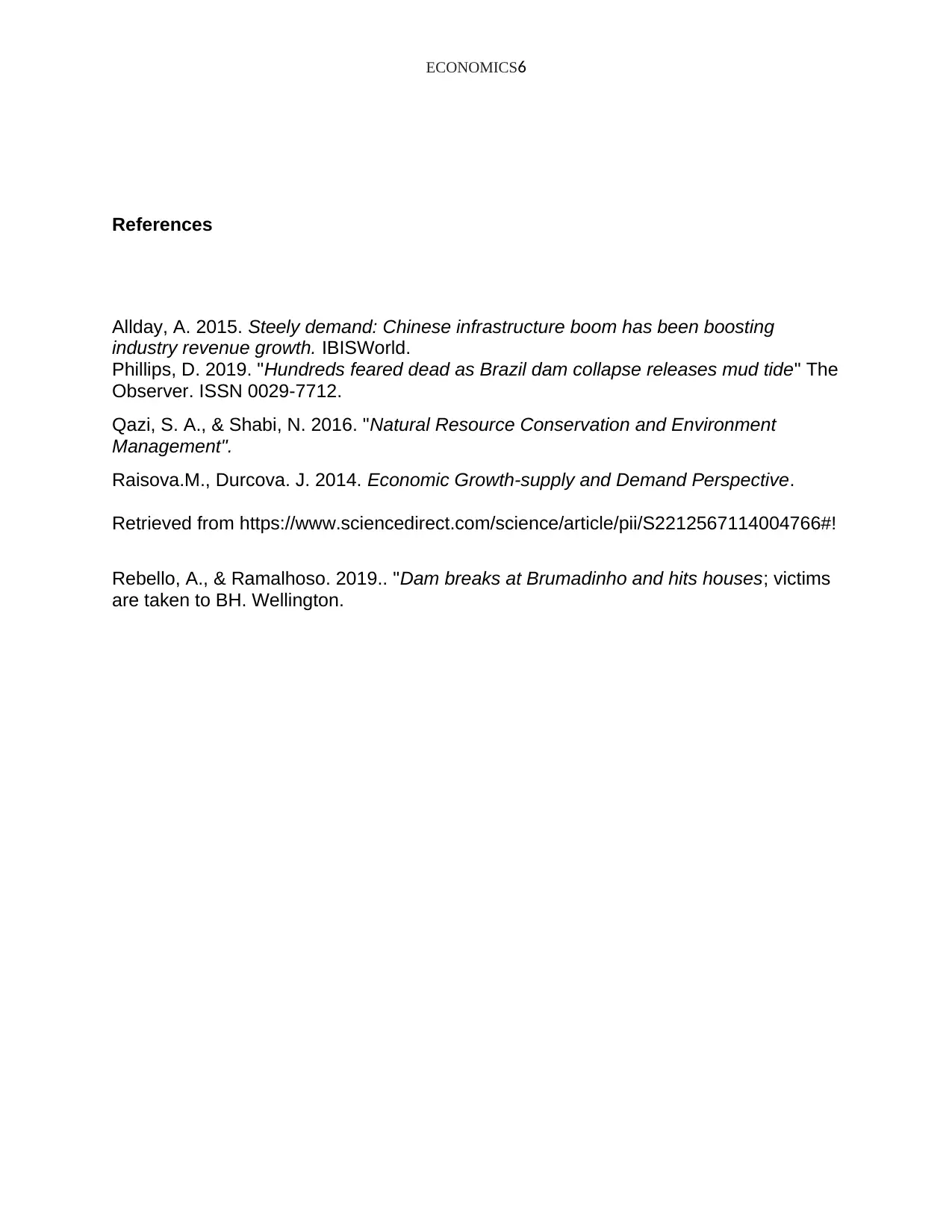
ECONOMICS6
References
Allday, A. 2015. Steely demand: Chinese infrastructure boom has been boosting
industry revenue growth. IBISWorld.
Phillips, D. 2019. "Hundreds feared dead as Brazil dam collapse releases mud tide" The
Observer. ISSN 0029-7712.
Qazi, S. A., & Shabi, N. 2016. "Natural Resource Conservation and Environment
Management".
Raisova.M., Durcova. J. 2014. Economic Growth-supply and Demand Perspective.
Retrieved from https://www.sciencedirect.com/science/article/pii/S2212567114004766#!
Rebello, A., & Ramalhoso. 2019.. "Dam breaks at Brumadinho and hits houses; victims
are taken to BH. Wellington.
References
Allday, A. 2015. Steely demand: Chinese infrastructure boom has been boosting
industry revenue growth. IBISWorld.
Phillips, D. 2019. "Hundreds feared dead as Brazil dam collapse releases mud tide" The
Observer. ISSN 0029-7712.
Qazi, S. A., & Shabi, N. 2016. "Natural Resource Conservation and Environment
Management".
Raisova.M., Durcova. J. 2014. Economic Growth-supply and Demand Perspective.
Retrieved from https://www.sciencedirect.com/science/article/pii/S2212567114004766#!
Rebello, A., & Ramalhoso. 2019.. "Dam breaks at Brumadinho and hits houses; victims
are taken to BH. Wellington.
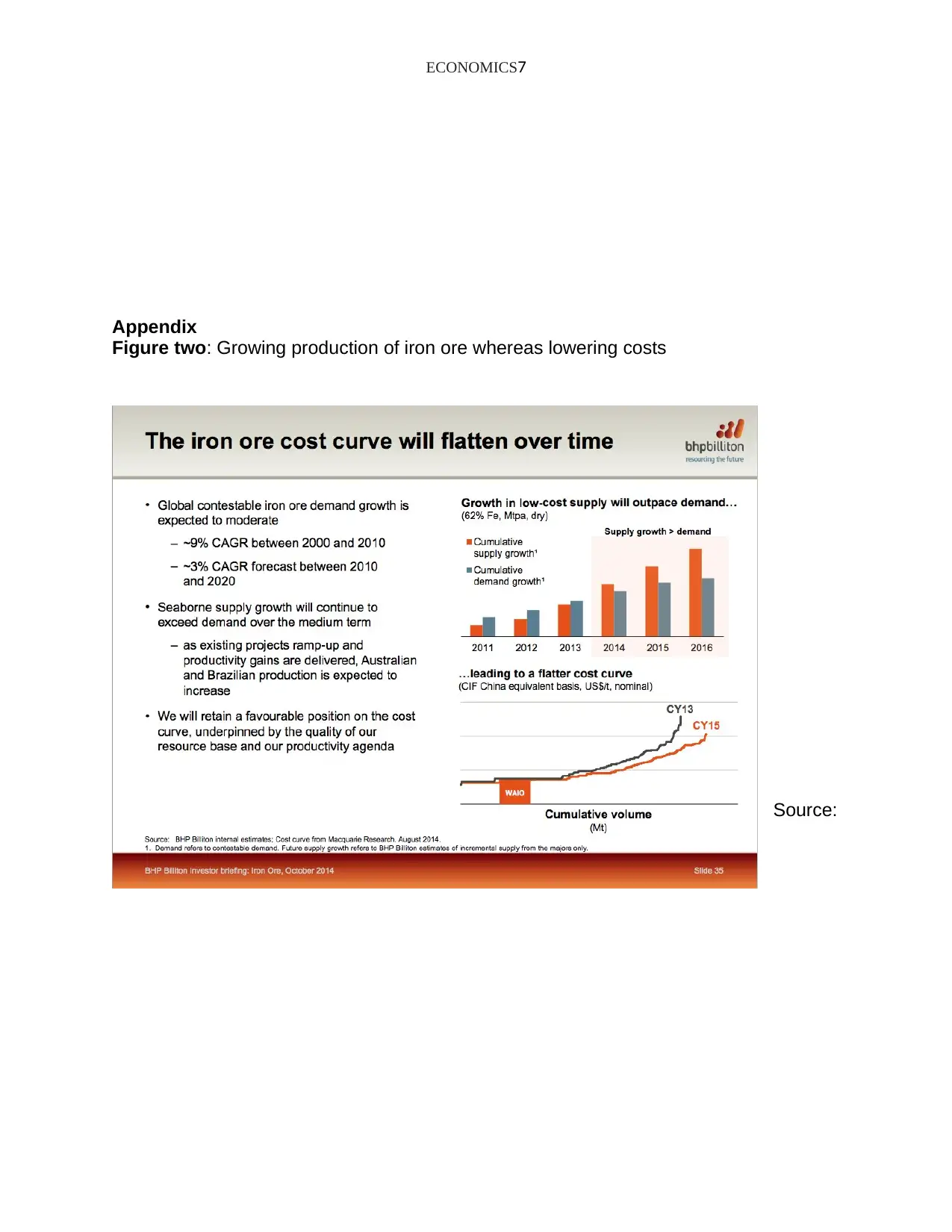
ECONOMICS7
Appendix
Figure two: Growing production of iron ore whereas lowering costs
Source:
Appendix
Figure two: Growing production of iron ore whereas lowering costs
Source:
1 out of 7
Your All-in-One AI-Powered Toolkit for Academic Success.
+13062052269
info@desklib.com
Available 24*7 on WhatsApp / Email
![[object Object]](/_next/static/media/star-bottom.7253800d.svg)
Unlock your academic potential
© 2024 | Zucol Services PVT LTD | All rights reserved.





